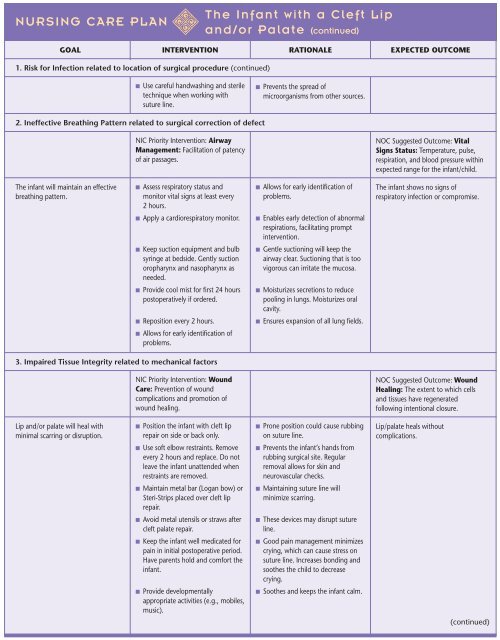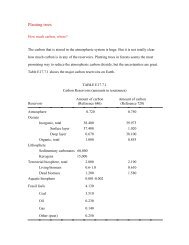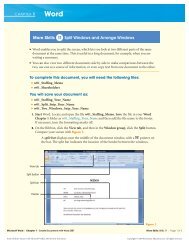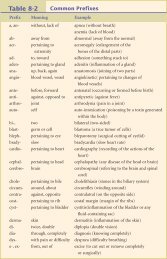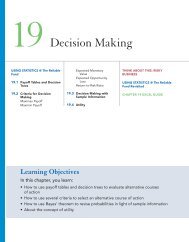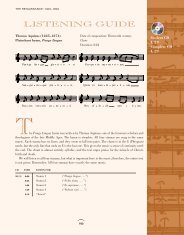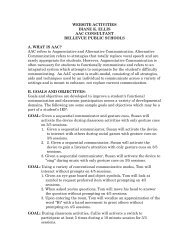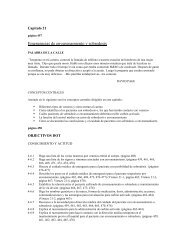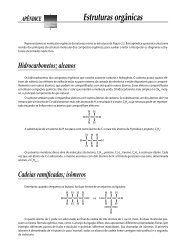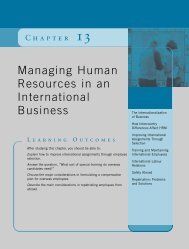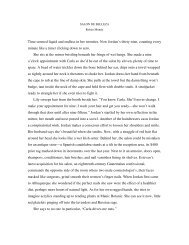590 NURSING CARE PLAN The Infant with a Cleft Lip and/or Palate
590 NURSING CARE PLAN The Infant with a Cleft Lip and/or Palate
590 NURSING CARE PLAN The Infant with a Cleft Lip and/or Palate
Create successful ePaper yourself
Turn your PDF publications into a flip-book with our unique Google optimized e-Paper software.
<strong>NURSING</strong> <strong>CARE</strong> <strong>PLAN</strong><br />
■ Use careful h<strong>and</strong>washing <strong>and</strong> sterile<br />
technique when w<strong>or</strong>king <strong>with</strong><br />
suture line.<br />
NIC Pri<strong>or</strong>ity Intervention: Airway<br />
Management: Facilitation of patency<br />
of air passages.<br />
■ Assess respirat<strong>or</strong>y status <strong>and</strong><br />
monit<strong>or</strong> vital signs at least every<br />
2 hours.<br />
■ Apply a cardi<strong>or</strong>espirat<strong>or</strong>y monit<strong>or</strong>.<br />
■ Keep suction equipment <strong>and</strong> bulb<br />
syringe at bedside. Gently suction<br />
<strong>or</strong>opharynx <strong>and</strong> nasopharynx as<br />
needed.<br />
■ Provide cool mist f<strong>or</strong> first 24 hours<br />
postoperatively if <strong>or</strong>dered.<br />
■ Reposition every 2 hours.<br />
■ Allows f<strong>or</strong> early identification of<br />
problems.<br />
NIC Pri<strong>or</strong>ity Intervention: Wound<br />
Care: Prevention of wound<br />
complications <strong>and</strong> promotion of<br />
wound healing.<br />
■ Position the infant <strong>with</strong> cleft lip<br />
repair on side <strong>or</strong> back only.<br />
■ Use soft elbow restraints. Remove<br />
every 2 hours <strong>and</strong> replace. Do not<br />
leave the infant unattended when<br />
restraints are removed.<br />
■ Maintain metal bar (Logan bow) <strong>or</strong><br />
Steri-Strips placed over cleft lip<br />
repair.<br />
■ Avoid metal utensils <strong>or</strong> straws after<br />
cleft palate repair.<br />
■ Keep the infant well medicated f<strong>or</strong><br />
pain in initial postoperative period.<br />
Have parents hold <strong>and</strong> comf<strong>or</strong>t the<br />
infant.<br />
■ Provide developmentally<br />
appropriate activities (e.g., mobiles,<br />
music).<br />
<strong>The</strong> <strong>Infant</strong> <strong>with</strong> a <strong>Cleft</strong> <strong>Lip</strong><br />
<strong>and</strong>/<strong>or</strong> <strong>Palate</strong> (continued)<br />
GOAL INTERVENTION RATIONALE EXPECTED OUTCOME<br />
1. Risk f<strong>or</strong> Infection related to location of surgical procedure (continued)<br />
2. Ineffective Breathing Pattern related to surgical c<strong>or</strong>rection of defect<br />
<strong>The</strong> infant will maintain an effective<br />
breathing pattern.<br />
3. Impaired Tissue Integrity related to mechanical fact<strong>or</strong>s<br />
<strong>Lip</strong> <strong>and</strong>/<strong>or</strong> palate will heal <strong>with</strong><br />
minimal scarring <strong>or</strong> disruption.<br />
■ Prevents the spread of<br />
micro<strong>or</strong>ganisms from other sources.<br />
■ Allows f<strong>or</strong> early identification of<br />
problems.<br />
■ Enables early detection of abn<strong>or</strong>mal<br />
respirations, facilitating prompt<br />
intervention.<br />
■ Gentle suctioning will keep the<br />
airway clear. Suctioning that is too<br />
vig<strong>or</strong>ous can irritate the mucosa.<br />
■ Moisturizes secretions to reduce<br />
pooling in lungs. Moisturizes <strong>or</strong>al<br />
cavity.<br />
■ Ensures expansion of all lung fields.<br />
■ Prone position could cause rubbing<br />
on suture line.<br />
■ Prevents the infant’s h<strong>and</strong>s from<br />
rubbing surgical site. Regular<br />
removal allows f<strong>or</strong> skin <strong>and</strong><br />
neurovascular checks.<br />
■ Maintaining suture line will<br />
minimize scarring.<br />
■ <strong>The</strong>se devices may disrupt suture<br />
line.<br />
■ Good pain management minimizes<br />
crying, which can cause stress on<br />
suture line. Increases bonding <strong>and</strong><br />
soothes the child to decrease<br />
crying.<br />
■ Soothes <strong>and</strong> keeps the infant calm.<br />
NOC Suggested Outcome: Vital<br />
Signs Status: Temperature, pulse,<br />
respiration, <strong>and</strong> blood pressure <strong>with</strong>in<br />
expected range f<strong>or</strong> the infant/child.<br />
<strong>The</strong> infant shows no signs of<br />
respirat<strong>or</strong>y infection <strong>or</strong> compromise.<br />
NOC Suggested Outcome: Wound<br />
Healing: <strong>The</strong> extent to which cells<br />
<strong>and</strong> tissues have regenerated<br />
following intentional closure.<br />
<strong>Lip</strong>/palate heals <strong>with</strong>out<br />
complications.<br />
(continued)


